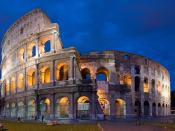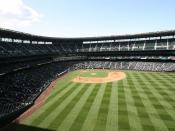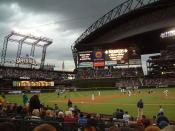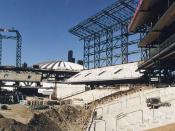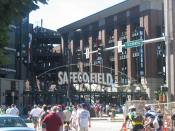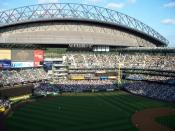Ancient Roman culture looked at gladiators, exotic animals, and comedic contests as form of entertainment; much as people in society today have adopted baseball for amusement. To meet the demand for entertainment both the Colosseum and SAFECO Field were constructed as platforms for athletes and others to dazzle the gathered crowds. Both structures allowed large masses of people to conjugate in one area and behold the festivities that brought them to the edge of their seats. The technology advancements in both eras have created an environment for all to gather. To accommodate the masses both stadiums were constructed in an elliptical shape which created different levels enabling everyone to see the events taking place at an emphases area in the center. To support the weight of many people both buildings uses columns and arches as architectural tools as well patterns for design. The very same ideas of arches and columns that were demonstrated on the Colosseum, aided in the creation of the retractable roof seen on SAFECO Field.
In fact, the roof of SAFECO Field is a large arched structure supported by massive steal columns (Howard, 2000). Today, being able to be ahead of our times is result from the classical age. Thus allowing us to proceed in the creation of new and different ideas. While both the Colosseum and Seattle's SAFECO Field were constructed for entertainment purposes and were considered marvels for their era, by analyzing their structure, means of construction, and size it becomes apparent the differences in the two stadiums.
During the reign of the Roman Empire, the Colosseum was looked upon as a magnificent structure that baffled the mind and inspired the imagination. People would journey from cities far from the roman capitol just to marvel at the size and technology the Colosseum displayed. The wooden floor where all the performances took place; possessed many gates and doors that retracted to reveal the hind chambers beneath. The complexity and intricate designs were far beyond the norm for the era. All these attributes lead to the Colosseum gaining its legendary status. While technology has undoubtedly evolved from the era of the Roman Empire to now, Seattle's SAFECO Field possesses much of the same status in our society as the Colosseum did in its time. Everything from the 655 foot retractable roof to the jumbo screen which uses the roof's steel beams for support, dazzles any baseball fan. Fans come from all over to view this amazing piece of artwork as they did the Roman Colosseum. Though the route to get to your seat may have been different it is easy to see how the seating was alike. The Colosseum had covered balconies accompanied by servants much like the luxury boxes of SAFECO Field. Women and poorer individuals stood or sat on wooden bleachers on the fourth level of the Colosseum. In order for them to get to their seats they had to climb steep, sloping ramps. Nowadays seats are more comfortable and come with arm rests. In order to get to these seats one would have to simply use the concrete stairway. But architectures today copied those of the Roman era. They both built each seat to allow the proper viewing level in front of them. Although the way to one's seat was slightly more convenient the architectural viewing level is the same.
From the perspective of an architect, the blueprints for both buildings needed the use of calculus to be built properly. Without the correct mathematics the buildings may have ended up lopsided or weak. In fact, it was in the Roman era that much of the math that is used to construct buildings ways documented and implemented into architecture. The Romans so ahead of their time were able to put four tiers together. Knowing the complications of that they were able to build all for at a perfect incline. Using hundreds of archways and columns for support. The exterior of the building was made with marble and concrete forming a unique support. The builders of today that constructed SAFECO Field applied the same mathematical techniques as the Romans. They too had to incline their 3 tier seating, but they went a step ahead. They had to perfectly place the lighting system which was made of stainless steel; to perfectly fit when the 22 million pounds of steel and fiber glass known as the retractable roof closes (Smith, 2000). As a result of these mathematical principles both buildings posses angular measurements equal to the area of circles, rectangles, and all types of triangles. Though the two buildings have an enormous gap in time between their constructions, the same mathematical formulas and postulates were used to insure the strength and congruence of the structures.
A final point of comparison is in the actual process in which the two stadiums were constructed. Both stadiums began with deep foundations that had to be created to combat the weak consistency of the soil in which the stadiums were built. Because both stadiums were constructed in basin areas close to sea level the soil was very loose and the foundations had to be deep enough to reach the condensed stone below. In SAFECO Field they put 1,400 pilings 90 feet below the ground to accommodate the oatmeal type soil. After the foundations were established, the use of arches and columns were implemented to create the general shape and support for the buildings. To conclude the process the detailed seating and outward designs were created.
While the purpose, status, seating, and general construction may have been highly similar, there exists many contrasting elements as well. The actual material that the stadiums consist of is very different. The Colosseum was constructed of primarily of an early form of concrete and wood; while SAFECO Field consist of manly of concrete, steal ,synthetic medals, and fiberglass. From an architectural stand point, the backbone of the Colosseum rests in the arches and columns. On the contrary, columns and arches simply aid the welded steal rods, simple wheels, and pulleys used to create SAFECO Field. The computers, motors, and other electronic components used to operate the field are other, more obvious, differences.
Along similar lines, the means of construction and amount of time needed for construction differs between the two stadiums. The Colosseum was constructed by the use of slave and animal labor. Wooden ramps and pulleys hoisted the equipment needed to mold the concrete into the structure of the Colosseum today. This grueling process took 10 years to complete. In comparison, SAFECO Field was constructed in only 27 ý months. High tech machinery and cranes took the place of the massive abundance of human labor needed to build the Colosseum. What makes the amount of time taken to build the stadiums even more amazing are the relative sizes. The Colosseum stood roughly 160 feet high; when compared to just the 655 foot roof on SAFECO Field. Surprisingly however, the Colossseum holds almost 5,000 more people than the capacity of SAFECO Field. Obviously the decorations and special features of the Colosseum are far less than the 56'X 60' scoreboard and 9 elevators of SAFECO Field. Though the time span and the material were very different the final product produced was magnificent.
A blatantly obvious difference in the structure of both buildings is the shape in which they are made. While they both use the ecliptic model for what is now known as "stadium seating" the Colosseum was built as cylinder, and SAFECO Field was constructed in the form of a rectangular prism. Because the Colosseum is cylindrical the dimensions from the center are all the same no matter what side the point of view is coming from. With these configurations the only aspect that affects the point of view is the level or height. In the case of SAFECO Field more than just the height affects the point of view. Because the seating is done in more of a triangular manner, the distance from the center focal point to the actual point of view can vary depending on the exact location along the triangle. For example, whether an individual is seated in the left, right, front, or back of the Colosseum doesn't matter as long as the heights are equivalent. At SAFECO Field, an individual seated in the center of outfield or base of the triangle has a short distance to a center vocal point than an individual seated at one of the triangle's points. Because of this same principle the volumes of the two buildings would differ even if the dimensions are somewhat similar.
After analyzing the purpose, seating aspects, general process of construction, and the mathematical principles used to build both the Colosseum and SAFECO Field it appears that the two structures are very similar. However when taking into consideration the means by which both builds were created it becomes noticeable that the two buildings share contrasting elements produced by the large amount of time that passed between the building of the two stadiums. In addition, the length of time needed to build each structure, shape, seating capacity, and technology all coincide as contrasting components. While both stadiums were, and in many ways still are marvels of their era, time has transcended many of the aspects of the creation of such structures. Through time slave labor has been replaced by machines, and limestone concrete constructions have given way to processed concrete and steel stadiums.
